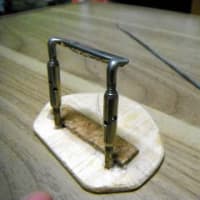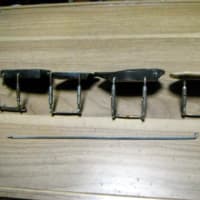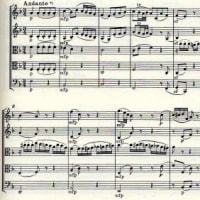08/14 私の音楽仲間 (88) ~ 偉大なる先輩
メンデルスゾーンの四重奏曲 ③
私の室内楽仲間たち (68)
これまでの 『私の室内楽仲間たち』
関連記事
ピアノ六重奏曲 ニ長調 Op.110
若々しいメニュー
弦楽八重奏曲 変ホ長調 Op.20
自己吟味の大家
八人で育む夢
魑魅魍魎
16歳の構成力
ヒマなアンサンブル
弦楽五重奏曲 第1番 イ長調 Op.18
瑞々し。 目まぐるし。
弦楽四重奏曲 第2番 イ短調 Op.13 他
いろはのイ
イ短調のパッション
偉大なる先輩
偉大なる理解者
「人生は死への…」
「…前座に過ぎない」
循環って、元に戻るの?
音色の妙味
解放と解答
弦楽四重奏曲 第1番 変ホ長調 Op.12
快速、快足、怪足
弦楽五重奏曲 第2番 変ロ長調 Op.87
スコットランドの夕映え
春になれば
弦楽四重奏のための4つの小品 Op.81
姉が手ほどき? 手招き?
弦楽四重奏曲 第6番 ヘ短調 Op.80
叫ぶ動機
呻きから慰めへ
18歳のメンデルスゾーンの力作、弦楽四重奏曲
イ短調 Op.13 (1827年)。
20分そこそこの曲なのですが、四つの楽章のどれにも、若き
作曲家の意気込みが感じられます。
だからこそチェロのSu.さんが、「詰め込むだけ詰め込んで
いる」と、この曲を表現したのでしょう。 「自分はメンデルス
ゾーンのマニアックなファンかもしれない」と、広言するほど
詳しい方ですから。
それで思い出すのは、彼が所属している市民オケの、ある
公演です。 私も招待状をいただいて本番を聴かせてもらった
のですが、曲目には交響曲第5番『宗教改革』が含まれて
いました。 この曲について熱っぽく語る彼の姿が、今でも
忘れられません。
ちなみにこのオーケストラには、私たちの重要なメンバー、
そしてお世話係のSa.さんのご家族も関係しておられます。
まったく世の中は狭いものです。
私がこの曲を体験して、しばらくしてからのことです。
インターネットで調べていたところ、英文サイトですが、
大変詳しい解説に行き当りました。
以下に記すのは、その内容を抜粋したものです。
全文は、このページの文末をクリックするとご覧いただけます。
(リンク切れに備えて、文章部分のみ保存してあります。)
それによれば、この曲は Beethoven の四重奏曲と
深く関係しているというのです。
第Ⅱ楽章は、ヘ短調 Op.95 と、
また終楽章は、イ短調 Op.132 との間に、
テーマの関連が見られるのだそうです。
下記のサイト内には、それぞれ上段、下段に譜例が見られます。
上はメンデルスゾーンの四重奏曲、
下は、該当する Beethoven の四重奏曲です。
[File:Mendelssohn Opus 13 Adagio Fugue.jpg]
[File:Mendelssohn Opus 13 Ad Libitum.jpg]
[File:Mendelssohn Opus 13 Presto.jpg]
ところが、偉大な先輩との関連は、これだけに終わりません
でした。
全曲の中心とも言える第Ⅰ楽章は、Beethoven の最後の
四重奏曲ヘ長調 Op.135 に触発されて出来たというのです。
(続く)
音源 Beethoven の四重奏曲
ベートーベン:弦楽四重奏曲第11番ヘ短調OP.95「セリオーソ」
(バリリ四重奏団 1952年録音)
ベートーベン:弦楽四重奏曲第11番「セリオーソ」
(ブダペスト弦楽四重奏団:1951年12月2日録音)
ベートーベン:弦楽四重奏曲第15番 イ短調 OP.132
(バリリ四重奏団 1956録音)
ベートーベン:弦楽四重奏曲第15番
(ブッシュ弦楽四重奏団 1937年録音)
ベートーベン:弦楽四重奏曲第15番
(ブダペスト弦楽四重奏団:1952年5月26~28日録音)
音源 メンデルスゾーンの四重奏曲イ短調
(前回までと同じものです)
第Ⅰ楽章
Freshman Quartet from Illinois State University
1st Movement
Quartet Danae
Natsuki Kumagai Violin Sophia Cho Violin
Leah Ferguson Viola Ben Fried Cello
1. Adagio-Allegro vivace
The Colburn School Ⅰ
Bloody Strings First Movement
1st Violin - Megan Sullivan
2nd Violin - Heeju Son
Viola - Jill Durham
Cello - Jacob Yates
Quartet Recital for the Dobson High School of Mesa Arizona
Ⅰ
Wenjia Xu, violin 1
Sean Yen, violin 2
Michael Jones, viola
Elizabeth White, cello
mvt. 1
The Escher String Quartet Ⅰ
Hudson Quartet first movement
William Shaub, Robin Su, Yohei Asada, and Seth Pae
Ⅰ
CAVANI String Quartet
ANNIE FULLARD, violin
MARI SATO, violin
KIRSTEN DOCTER, viola
MERRY PECKHAM, cello
I. Adagio - Allegro Vivace
Anna Savelsberg, violin
Bettina Kurz, violin
Matthew Williams, viola
Raphael Heggendorn, cello
First Movement
Laura Ha & Adrianna Mateo, violins;
Talya Schenk, viola; Jamie Song, cello.
Ⅰ
Seraphina String Quartet
I: Adagio, Allegro Vivacez
Annie Wang-Violin
Alice Hong-Violin
Zenas Han-Viola
Gracie Sommer-Cello
Adagio, Allegro Vivace (部分) Ⅰ
第Ⅰ、Ⅱ楽章
Arcano string quartet
Erik Sanchez Mariana Valencia
Miguel Alcantara Luz del Carmen
1er Mov. 2do mov.
第Ⅱ楽章
Eusia String Quartet 2nd mvt
第Ⅱ、Ⅲ楽章
Orion String Quartet & CMW Ⅱ Ⅲ
第Ⅳ楽章
Música de Cámara en la Universidad Católica.
Violeta Mura, Valentina Maza, Diana Brown, Alvaro Carreño
IV Movement
第Ⅰ、Ⅲ、Ⅳ楽章
National Chamber Ensemble
Leonid Sushansky, Najin Kim (violins),
Uri Wassertzug (Viola), Lukasz Szyrner (Cello)
Mvmt 1 Ⅲ Mvmt 4
第Ⅱ、Ⅲ、Ⅳ楽章
VERONIKA STRING QUARTET
2nd
3rd mvt
4th mvt
全楽章
Sirius Quartet
First Movement
2nd Movement
3rd Movement
last Movement
ELYX Quartet
1st movement - Adagio, Allegro vivace
2nd movement - Adagio non lento
3rd movement - Intermezzo. Allegretto con moto, Allegro di molto
4th movement - Presto
以下は[String Quartet No. 2 (Mendelssohn)]の内容をそのまま転載したもので、順番を整理して若干見やすくしてあります。
The String Quartet No. 2 in A minor, Op. 13, was composed by Felix Mendelssohn in 1827[1]. Written when he was 18 years old, it was Mendelssohn's second string quartet. The quartet draws much of its inspiration from Beethoven's quartets.
Movements
This work has four movements:
1. Adagio ? Allegro vivace
2. Adagio non lento
3. Intermezzo: Allegretto con moto ? Allegro di molto
4. Presto ? Adagio non lento
A typical performance lasts about 20 minutes.
Composition
Though Mendelssohn was still a teenager when he wrote this quartet, he was already an experienced composer of chamber music. In addition to the first quartet, opus 12, he had written the string quintet opus 18, the octet for strings opus 20, and two piano quartets. He had a few months before produced his opera Die Hochzeit von Camacho, which was not a success.
Mendelssohn wrote the quartet two years after Ludwig van Beethoven published his last quartets, and months after his death. Beethoven's late quartets received a lukewarm reception at best, and many ? including Mendelssohn's own father ? agreed with composer Louis Spohr that they were an "indecipherable, uncorrected horror"[citation needed]. Mendelssohn, however, was fascinated by them. He studied the scores, and included many quotes from Beethoven's quartets in opus 13.
As a unifying motif, Mendelssohn included a quote from the song "Ist es wahr?" (Is it true?), which he composed a few months earlier, for baritone and piano, based on a poem by Johann Gustav Droyson: "Is it true that you are always waiting for me in the arbored walk?" Mendelssohn includes the title of the song in the score of the quartet, recalling the title Beethoven wrote on the last movement of his Op. 135 string quartet "Muss es sein?" (Must it be?). But, unlike the introspective, existential quality of Beethoven's quartet, Mendelssohn's work is richly romantic. "...This quartet, relying heavily on compositional techniques of late Beethoven, links Classical form to Romantic expression," writes analyst Lucy Miller[2].
Analysis
The motif of Mendelssohn's song "Ist es Wahr?", and the motif as it appears in the opening Adagio of the quartet.
File:Mendelssohn Opus 13 Ist Es Wahr.jpg
The fugal motifs from the slow movements of Mendelssohn's Opus 13 (top) and Beethoven's Opus 95 (bottom). Second violin and viola parts are shown.The three-note motif from "Ist es wahr?", presented in an opening Adagio in the key of A Major, establishes the cyclic form of the quartet; the motif appears in all four of the movements, and concludes the quartet[3]. After the Adagio introduction, the quartet breaks into a tumultuous Allegro Vivace in Sonata form in A minor. So the quartet, which is mostly in minor keys, and is primarily minor in character, opens and closes in a major key ? a rather daring departure from standard quartet-writing practice of the time. The opening closely resembles Beethoven's Op. 132 quartet[4]: that quartet, also, has an opening adagio, then a first theme built of running sixteenth notes and a lyrical passage, which is close to an inversion of Mendelssohn's theme.
File:Mendelssohn Opus 13 Adagio Fugue.jpg
The Adagio movement has a middle slow, fugal section which is modelled after the fugal middle section of the slow movement of Beethoven's Op. 95. The subjects of both fugues are sinuous melodies that slide down chromatically, moving from viola to second violin and then to the other voices. Like the Beethoven model, the fugue goes through a series of increasingly complex variations with cross-rhythms in the different instruments.
The Intermezzo movement opens with a light, gossamer theme which is Mendelssohn's signature style. The lilting theme in the first violin, with pizzicato accompaniment in the other instruments, recalls the overture to the incidental music to A Midsummer Night's Dream (op. 61) and scherzo movements from many of Mendelssohn's chamber works.
File:Mendelssohn Opus 13 Intermezzo.jpg
The theme of the Intermezzo movement, with lyrical violin theme and pizzicato accompaniment.
The final movement of Beethoven's Op. 132 quartet is a prototype for Mendelssohn's last movement: it begins with a cadenza interlude in the first violin, leading into a fast, melodic movement with a driving bass line in the cello which is a close copy of the cello part of Op. 132.
File:Mendelssohn Opus 13 Ad Libitum.jpg
The violin cadenzas, with tremolo accompaniment, that introduce the final movements of the Mendelssohn quartet (top) and the Beethoven opus 132 (bottom). First and second violin parts shown.
File:Mendelssohn Opus 13 Presto.jpg
The themes of the finales of the Mendelssohn quartet and Beethoven opus 132. Note the similarity between the cello parts and the interlocking inner voice (viola part in the Mendelssohn, second violin in the Beethoven. Fourth part not shown).


















※コメント投稿者のブログIDはブログ作成者のみに通知されます